The main purpose of this ongoing blog will be to track global extreme or record temperatures related to climate change. Any reports I see of ETs will be listed below the main topic of the day. I’ll refer to extreme or record temperatures as ETs (not extraterrestrials).😉
Main Topic: Black Sea Grows Darker After Major Tanker Spill
Dear Diary. Tragic scenes of blackened oily beaches and wildlife will only continue until the planet gets rid of tankers and converts to using renewable energy. Like all corporations, those involved with shipping want to cut costs. Building new tankers and inspecting older ships costs money, so of course spills continue to occur, especially from 50–60-year-old tankers that should be mothballed. So, we have a proverbial greedy candle burning at both ends from both fossil fuel interests and shipping companies.
So, over the weekend, I’m not surprised to learn about another major oil spill, this time in the war torn Black Sea region. Here are more details from the Washington Post:
https://www.washingtonpost.com/world/2025/01/27/russia-crimea-oil-spill-birds-rescue
More than 10,000 people have been working to shovel up the oil from beaches after a spill in the Black Sea in December. (Video: Reuters)
By Mary Ilyushina and Natalia Abbakumova
Over the past month, the popular Black Sea resort beaches of Russia’s Krasnodar region have been transformed into a scene out of a dystopian sci-fi film, with thousands of workers in white hazmat suits swarming the blackened coast amid dead birds and dolphins.
The workers’ task is grueling and repetitive: manually sifting tons of sand and bagging large clumps of contaminated soil to remove the toxic black sludge from the beaches. Waves bring fresh deposits of the tar-like substance, and the work begins again.
This Sisyphean cleanup is a result of a mid-December incident in which two aging oil tankers were caught in a storm and broke in half in the Kerch Strait, spilling 2,500 to 4,500 tons of fuel oil into the Black Sea, according to Greenpeace. An estimated 40 miles of Krasnodar’s coastline has been affected, with the oil also washing up across the strait in Crimea.
Even as volunteers from across Russia flooded in to help, the crisis was at first largely ignored by local and federal officials, highlighting a pervasive lack of official concern over the numerous environmental disasters in the country often resulting from negligence, according to Russian scientists and environmental activists.
“It is an unprecedented event,” Viktor Danilov-Danilyan, chief scientist at the Institute of Water Problems at the Russian Academy of Sciences, told broadcaster RBC. “This is the most serious environmental disaster in Russia since the beginning of the 21st century.” He estimated that without extensive human intervention, it would take 15 to 20 years for the ecosystem to restore itself.
During the accident, the tanker Volgoneft 212 sank, while the other vessel, the Volgoneft 239, was stranded at Cape Panagia, a few hundred feet from the shore, still filled with fuel oil.
Greenpeace has estimated the size of the area affected to be about 400 square miles, but with much of the oil underwater, it is difficult to determine. While the spill is not as large as some more-notorious incidents — the Exxon Valdez, which ran aground in 1989 off Alaska, was carrying 35,000 tons of crude oil, though that’s lighter than fuel oil — it is one of the biggest for Russia and more than double the size of a spill in the same region in 2007.
As the oil sinks, it kills all living things, poisoning fish, dolphins, mollusks and plankton. Undercurrents spread the spill and can bring oil to the surface, where it traps birds.
Sounding the alarm
Local environmentalists immediately rang alarm bells, setting up Telegram group chats to coordinate efforts and find accommodations for people flocking in from other regions to help. These activists handled most of the on-site cleanup efforts in the first week after the incident, according to volunteers interviewed by The Washington Post and scientists quoted by Russian media.
The regional authorities of Krasnodar initially did not request federal help, even though each tanker was loaded with about 4,500 tons of fuel.
“This is absurd as this is a large-scale disaster,” Dmitry Shevchenko, an activist from the Krasnodar region, told RBC at the end of December. “It was necessary to immediately involve federal forces while it had not yet reached such a scale.”
In a statement on Dec. 25, Gov. Veniamin Kondratyev said the oil was still washing ashore and “has dragged on and does not stop” despite assurances from scientists that it would sink to the bottom. He upgraded the spill from a municipal to a regional emergency, describing the situation as “tense.”
The regional government did not respond to questions about why it took so long to bring in federal authorities.
Meanwhile, the volunteers quickly ran into a resource issue — a lack of protective gear to keep people from being sickened by the toxic fumes. The bags of sand they collected also remained at the beach as local authorities lacked the capacity to take them away for processing.
Residents began to record video addresses to the Kremlin urging it to send reinforcements.
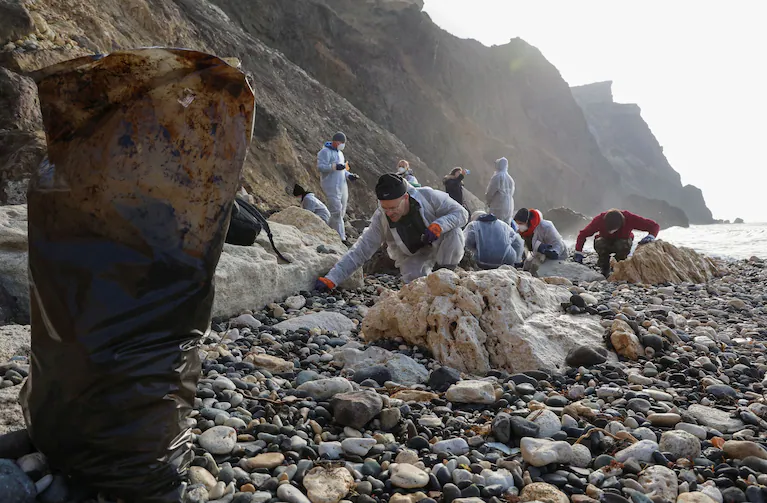
Volunteers in Crimea work on Jan. 9 to clear spilled oil after two tankers were damaged in a storm in the Kerch Strait. (Alexey Pavlishak/Reuters)
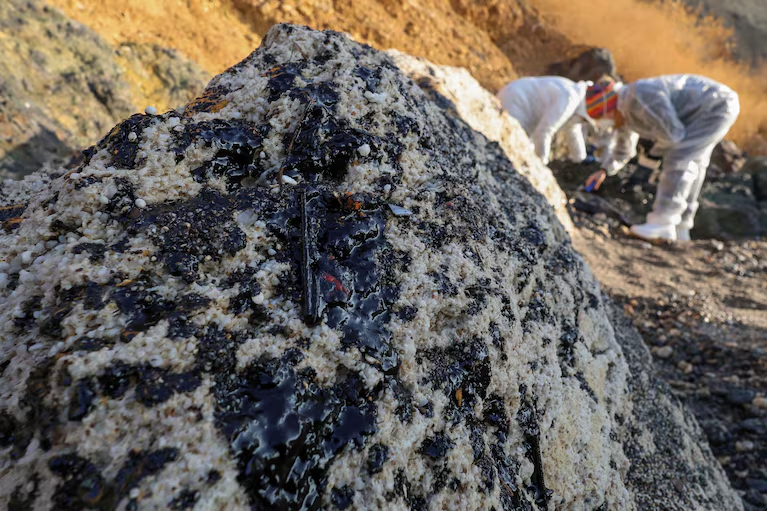
A pile of the black clumps scraped up by the volunteers. (Alexey Pavlishak/Reuters)
At least 60 dead dolphins have been found off Novorossiysk, Anapa and Taman since the spill, and an additional 34 dead animals turned up on Crimea and near its city of Sevastopol, areas Russia illegally annexed from Ukraine in 2014. Ivan Rusev, a biologist and head of the research department at Tuzlovski Limany National Park, estimates the spill also killed thousands of birds.
“I think that 15,000 to 20,000 were found dead, but this is just the tip of the iceberg,” he told Radio Free Europe. “There are still a lot of birds floundering in the sea. They are under stress and will soon be [washing up] on the shore.”
Systemic problems
In his interview with RBC, scientist Danilov-Danilyan attributed the disaster to systematic negligence and disregard for safety measures, a pervasive problem across Russian institutions.
The tankers were built in 1969 and 1973 and lacked proper permits, casting their seaworthiness into doubt. Russia’s Investigative Committee has launched a probe into the operator, which local media reported had already faced legal checks over safety violations in recent years.
“At the very least, they should not have been using vessels that should have been written off 20 years ago. In principle, river-sea vessels should not be released for winter sea navigation,” he said. “It is impossible to avoid catastrophic consequences with such an attitude — sooner or later it would have occurred. And serious work to eliminate the consequences began only on the ninth or 10th day after the accident.”
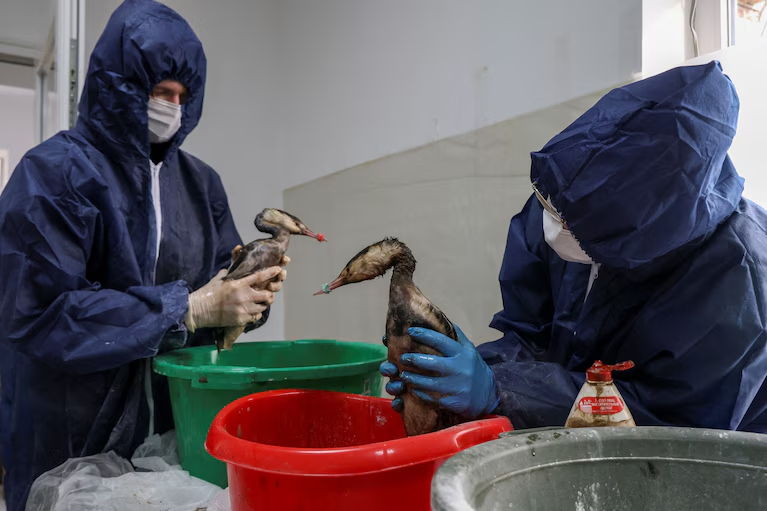
Volunteers working at a veterinary clinic in the Crimean resort city of Saki clean up birds caught in the spill. (Alexey Pavlishak/Reuters)
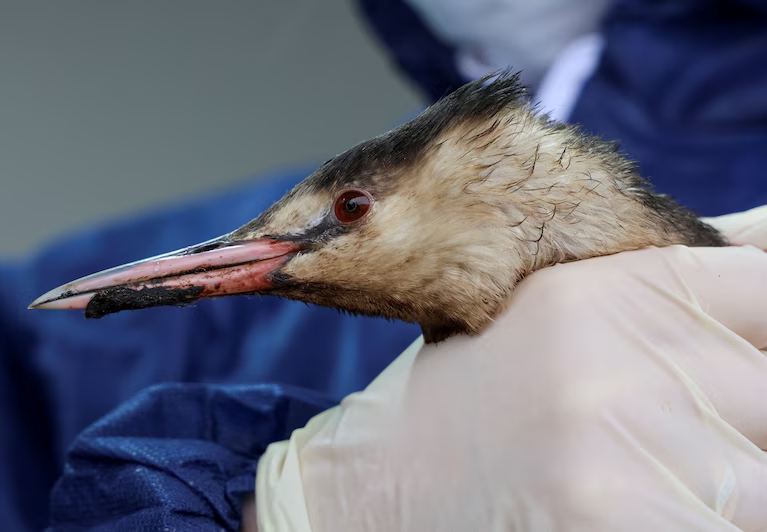
A bird with sludge still on its beak. (Alexey Pavlishak/Reuters)
Nearly a month after the accident, on Jan. 9, the Kremlin stepped in. During a government meeting, President Vladimir Putin issued orders to establish a nationwide response team and scolded local officials for failing to do “enough” to mitigate damage from the spill.
The following day, a new leak began on the stranded Volgoneft 239, but it was 10 more days before the fuel removal from that vessel began, according to state news agency Tass.
“I would give the actions of authorities in terms of removing the sunken part and especially the stranded tanker a solid F,” said Dmitry Lisitsyn, an environmentalist who once worked on Russia’s Pacific island of Sakhalin before the Kremlin branded his organization a foreign agent, forcing him out of the country. “It is a mystery why they waited until the tanker started leaking again to begin pumping the fuel.”
Popular outcry
It appears that public outrage and the sight of thousands of volunteers arriving over the New Year’s holiday may have been instrumental in spurring the federal government to action.
Karina Shahparonova and a few of her friends took time off work and drove to the Krasnodar region from Moscow this month.
“It is very difficult to clean it up because this fuel is a bit like mercury — it splits and disintegrates into small little pieces, small cakes, occasionally somewhat large, all over the beach,” she said. “So we have to gather it all. Some comb the sand with rakes, some with sieves, some with gloves, some with shovels.”
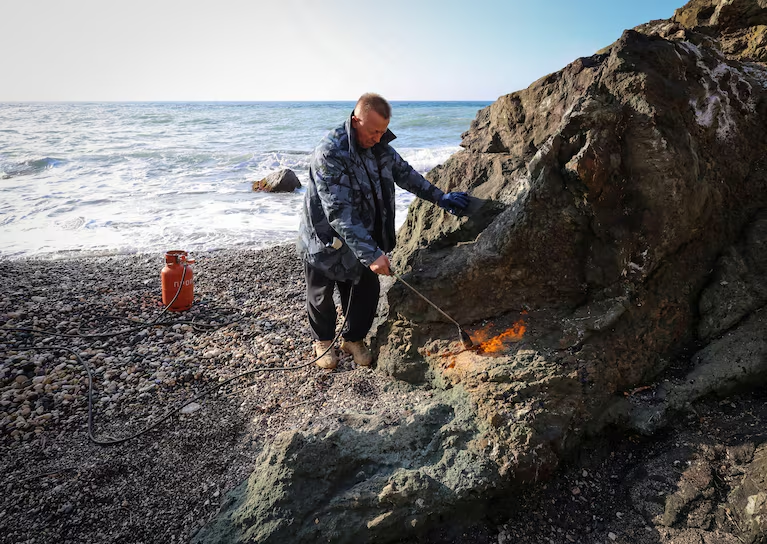
A volunteer burns spilled oil on Cape Fiolent in Sevastopol, Crimea. (Alexey Pavlishak/Reuters)
Shahparonova said she had no experience as a volunteer but was moved by the photos and videos emerging from the affected zones. She praised the government efforts in organizing lodging and equipment for the volunteers, but was puzzled as to why it took the authorities so long to isolate the tankers.
Lisitsyn, the environmentalist, argued that swifter government action could have prevented leaks that kept damaging the environment.
Russia’s Transportation Ministry has described the spill as “the world’s first accident involving ‘heavy’ M100 fuel oil” and said it would be extremely difficult to collect it from the water because it does not float to the surface.
About 5,000 tons of fuel oil are still lying on the seabed, officials say. Lisitsyn said the situation will worsen toward the summer as temperatures rise, when the remaining fuel, under heat, will release more toxic particles.
“The 2025 holiday seasons there will certainly be ruined because, despite the truly heroic efforts, it is impossible to remove all fuel oil from the beach,” he said. “Therefore, people who go to this beach will breathe in harmful, very toxic, volatile compounds that are just not that volatile now.”
The sunken tanker, meanwhile, remains 20 meters underwater, and its fuel oil continues to seep into the water. According to the Telegram coordination chats, there is now also a shortage of workers as the influx of cleanup volunteers has subsided.
Understanding the Russia-Ukraine conflict:
HAND CURATED
- What the Pentagon has learned from two years of war in UkraineFebruary 22, 2024
- Ukraine’s gamble in Russia has yet to slow Moscow’s eastern assaultAugust 31, 2024
- Mapping Ukraine’s incursion in Russia August 12, 2024
View 3 more storiesView 3 more stories

By Mary IlyushinaMary Ilyushina, a reporter on the Foreign Desk of The Washington Post, covers Russia and the region. She began her career in independent Russian media before joining CNN’s Moscow bureau as a field producer in 2017. She has been with The Post since 2021. She speaks Russian, English, Ukrainian and Arabic.follow on X@maryilyushina

By Natalia Abbakumova Natalia Abbakumova is a researcher for The Washington Post’s Moscow Bureau.
Here are more “ETs” recorded from around the planet the last couple of days, their consequences, and some extreme temperature outlooks, as well as any extreme precipitation reports:
Here is More Climate News from Monday:
(As usual, this will be a fluid post in which more information gets added during the day as it crosses my radar, crediting all who have put it on-line. Items will be archived on this site for posterity. In most instances click on the pictures of each tweet to see each article. The most noteworthy items will be listed first.)